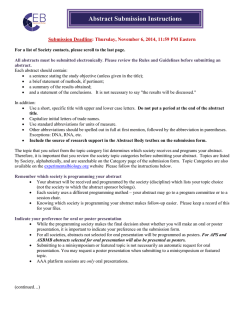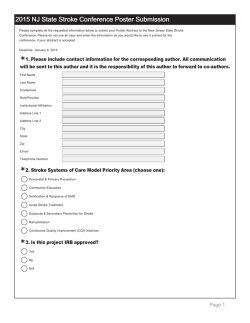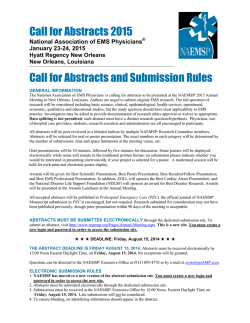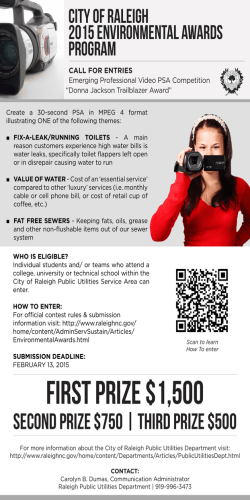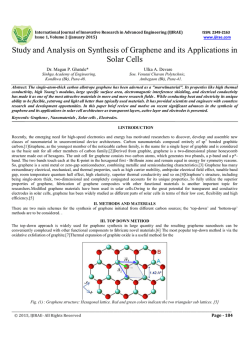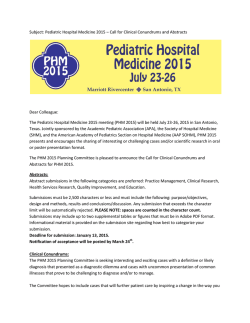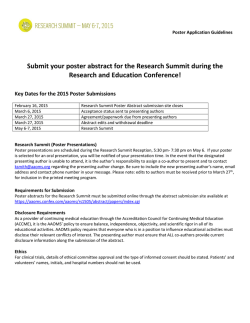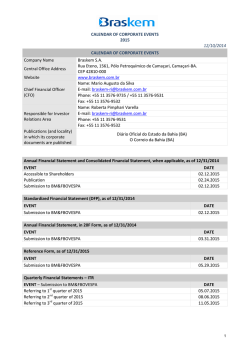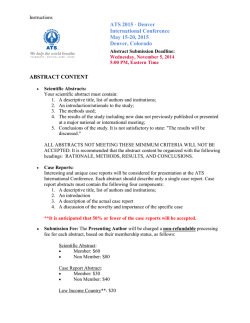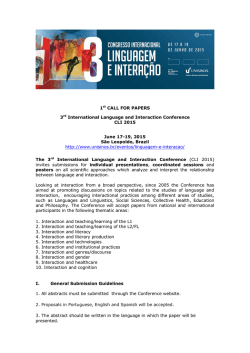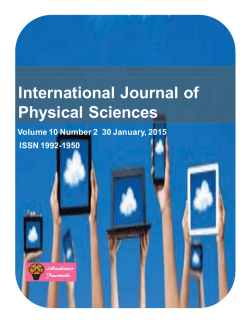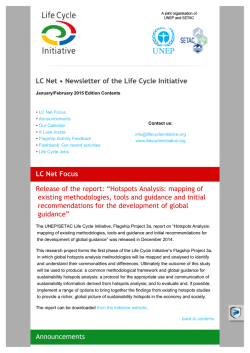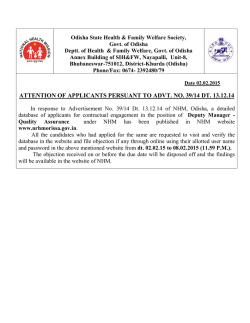
Joint Transnational Call 2015 Graphene Flagship Human Brain
Joint Transnational Call 2015 for transnational research projects in synergy with the two FET Flagships Graphene Flagship Human Brain Project Call Announcement Deadline: 27 January 2015, 17:00CET Documents and procedures: http://www.flagera.eu FLAG-ERA Joint Call Secretariat: Emilie Klecha +33 1 73 54 82 98 [email protected] Indicative budget: € 18.510.000 Index Introduction ...........................................................................................................................................3 Topics & JTC participant organisations .................................................................................................4 Eligibility .................................................................................................................................................6 Eligibility of the Consortium ..................................................................................................................6 Eligibility of Partners ..............................................................................................................................7 Duration ................................................................................................................................................7 Financial and legal modalities .................................................................................................................7 Application Procedure ...........................................................................................................................7 Submission of joint transnational proposals ..........................................................................................8 Further information ...............................................................................................................................8 Association to the Flagship ....................................................................................................................9 Management of Projects ........................................................................................................................9 Setting up the Consortium ....................................................................................................................9 Reporting and Publications ................................................................................................................. 10 ANNEX I - JTC Graphene Areas ........................................................................................................... 11 ANNEX II- JTC HBP Areas..................................................................................................................... 17 ANNEX III – NATIONAL REQUIREMENTS ............................................................................................. 23 FLAG-ERA JTC 2015 Call Announcement 2 Introduction FLAG-ERA stands for ‘Flagship ERA-NET’ and gathers National and Regional Funding Organisations (NRFOs) in Europe and beyond with the goal of supporting, together with the European Commission (EC), the FET Flagship initiatives, i.e., the Graphene Flagship and the Human Brain Project (HBP) Flagship. One of its main aims is to allow researchers to complement the current Flagship projects and to collaborate towards the achievement of their vision through the use of existing or dedicated transnational, national and regional calls. In particular, FLAG-ERA aims at launching dedicated joint transnational calls (JTCs) allowing researchers from several countries to jointly contribute to the Flagship goals. The NRFOs participating to this call are listed below. Note that the list of participating NRFOs depends on the Flagship. The JTC will be conducted simultaneously by these NRFOs and coordinated centrally by the Joint Call Secretariat (JCS). The NRFO Contact Points (CPs) are provided in Annex III, and the contact information of the JCS is provided on the front page of the present Call Announcement. The descriptions of the scientific areas for this call are provided in Annexes I & II (headings are provided below). These areas are those identified as priorities to complement the Flagships. Only proposals falling into these areas will be considered. FLAG-ERA JTC 2015 Call Announcement 3 Topics & JTC participant organisations Graphene JTC Areas 1. 2. 3. 4. 5. 6. 7. 8. 9. 10. 11. Computational modelling of devices and systems Advanced nanofabrication and spintronics Active THz components Multifunctional composites Functional coatings Nanofluidics applications Biological and chemical sensors Immunogenomics and proteomics New layered materials and heterostructures Energy Prototypes Detailed information available in Annex I. NRFOs participating in the Graphene topic Funding Organisation Country Indicative Budget (€) 300.000 Fonds zur Förderung der wissenschaftlichen Forschung (FWF) Austria Fonds de la Recherche Scientifique (FRS-FNRS) Belgium 200.000 Fonds Wetenschappelijk Onderzoek – Vlaanderen (FWO) Belgium 400.000 Agentschap voor Innovatie door Wetenschap en Technologie (IWT) Belgium 750.000 Agence Nationale de la Recherche (ANR) France 1.000.000 Deutsche Forschungsgemeinschaft (DFG) Germany 2.400.000 Nemzeti Innovációs Hivatal (NIH) Hungary Ministero dell’ Istruzione, dell’ Università e della Ricerca (MIUR) Latvijas Zinatnu Akademija (LZA) Stichting voor Fundamenteel Onderzoek der Materie (FOM) Italy Latvia Netherlands Narodowe Centrum Badań i Rozwoju (NCBR) Poland 500.000 Fundação para a Ciência e a Tecnologia (FCT) Portugal 250.000 Unitatea Executiva pentru Finantarea Invatamantului Superior, a Cercetarii, Dezvoltarii si Inovarii (UEFISCDI) Romania 500.000 Ministerio de Economía y Competitividad (MINECO) Spain 500.000 Verket för Innovationssystem (VINNOVA), Vetenskapsradet - Swedish Research Council (VR) Sweden 1.500.000 The Scientific and Technological Research Council of Turkey (TUBITAK) Turkey 1.000.000 330.000 1.000.000* 200.000 750.000 *MIUR funding allocation is made of €500.000 as grant and €500.000 as loan FLAG-ERA JTC 2015 Call Announcement 4 HBP JTC Areas 1. 2. 3. 4. 5. 6. 7. 8. 9. 10. Targeted Mapping of the Mouse Brain Targeted Mapping of the Human Brain Theoretical and Mathematical Foundations of Neuroscience Neuroinformatics Brain Simulation High Performance Computing Medical informatics Neuromorphic Computing Neurorobotics Ethics and Society Detailed information available in Annex II. NRFOs participating in the HBP topic Funding Organisation Country Indicative Budget (€) Fonds zur Förderung der wissenschaftlichen Forschung (FWF) Austria 300.000 Fonds de la Recherche Scientifique (FRS-FNRS) Belgium 200.000 Fonds Wetenschappelijk Onderzoek – Vlaanderen (FWO) Belgium 400.000 Agentschap voor Innovatie door Wetenschap en Technologie (IWT) Belgium 750.000 Agence Nationale de la Recherche (ANR) France Nemzeti Innovációs Hivatal (NIH) Hungary Ministero dell’ Istruzione, dell’ Università e della Ricerca (MIUR) Italy Latvijas Zinatnu Akademija (LZA) Latvia 200.000 Nederlandse Organisatie voor Wetenschappelijk Onderzoek (NWO) Netherlands 750.000 Fundação para a Ciência e a Tecnologia (FCT) Portugal 250.000 Unitatea Executiva pentru Finantarea Invatamantului Superior, a Cercetarii, Romania Dezvoltarii si Inovarii (UEFISCDI) 500.000 Ministerio de Economia y Competitividad (MINECO) Spain 500.000 The Scientific and Technological Research Council of Turkey(TUBITAK) Turkey 750.000 1.000.000 330.000 1.000.000* *MIUR funding allocation is made of €500.000 as grant and €500.000 as loan FLAG-ERA JTC 2015 Call Announcement 5 Eligibility Proposals are submitted by international consortia with partners (research groups) in multiple countries. The FLAG-ERA joint transnational call is a hybrid funding instrument. The proposal evaluation and selection are international. Funding is then provided by participating funding organisations directly to the selected consortium partners. If a partner may be eligible to receive funding by multiple participating organisations, the partner must choose a single organisation for funding. It is both necessary that the consortium is eligible for FLAG-ERA, and that all partners are eligible to be funded by their chosen organisation. Each partner is directed by a principal investigator (PI), who will interact with the funding organisation. One partner acts as the coordinator for the consortium and is the single point of contact with FLAG-ERA. Eligibility of the Consortium Each consortium submitting a proposal must involve at least 3 partners from 3 different countries and fulfil at least one of the following two options: At least three partners requesting funding from three different countries participating in the JTC. Or At least two partners requesting funding from two different countries participating in the JTC plus a Flagship Core Project partner from a different country, not requesting funding in the framework of the call and securing its own funding. Besides, not more than half of the partners in a consortium can be Flagship Core Project partners, independently of whether they request funding or not. A partner is defined as any research group from a research performing organisation working in the topic of the JTC, unless otherwise stated in the National Annexes (annex III). A Flagship Core Project partner is defined as a partner directed by a PI which is also a PI for the Flagship Core Project at submission time. Each PI in a consortium has to declare if he or she is a PI in the Flagship Core Project during the submission process. The consortium coordinator must be a partner funded by an organisation participating in the call. The maximum requested funding allowed per country in a proposal is 60% of the total requested funding of the proposal, except if only partners from 2 countries apply for funding, in which case this figure is raised to 75%. In addition to the Flagship Core Project partners, research groups or private partners performing research who are not eligible to receive funding by any organisation participating FLAG-ERA JTC 2015 Call Announcement 6 in the call but are willing to collaborate and contribute to the proposed project may be part of a consortium if they are able to secure their own funding. Such partners are not considered in the computation of the proportion of Flagship Core Project partners in the consortium, and third-party funding is not considered for the application of the above-mentioned 60% or 75% rule. Eligibility of Partners The eligibility criteria for partners are specific to the chosen funding organisation. Be aware that some funding organisations: require that eligibility of partners is checked with them prior to applying; fund only basic research or only applied and/or innovation-related research. Details as well as contact points are found in Annex III. In order not to jeopardize the whole consortium, each partner in the consortium should ensure that no doubts exist about the eligibility of their institution (university, academic institutions, industry), the eligibility of their PI (permanent staff, position secured for the duration of the project, etc.), and their eligible costs. Duration Projects may be funded for a period of up to three years and according to individual funding organisation regulations (see Annex III). Financial and legal modalities Eligible costs may vary according to the corresponding funding organisation regulations. Each group will be subject to the rules and regulations of its respective national/regional funding organisation. Application Procedure Ensure the proposal is valid: The research is in line with one of the two topics of the call. The consortium meets the eligibility criteria. Each partner meets the eligibility criteria. It is the responsibility of each partner to ensure their eligibility. Check the detailed regulations of each organisation in Annex III for partner-specific conditions. Please make sure that all partners who must contact their funding organisation prior to submission have done so. FLAG-ERA JTC 2015 Call Announcement 7 Submission of joint transnational proposals A one stage submission of proposals process applies. One joint proposal document (in English, maximum 30 pages, in PDF format) shall be prepared by the partners of a joint transnational proposal, and must be submitted to the Joint Call Secretariat by one spokesperson, the coordinator. Proposals must be submitted in electronic format no later than 27 January, 2015 (17:00 CET) via the electronic submission system (http://submission.flagera.eu/). It is recommended that a preliminary proposal be submitted several days before the deadline to guarantee against unforeseen issues. Proposals that have already been submitted can be modified until the deadline. Partners whose funding organisation requires submitting forms alongside the consortium application must do so at this point. The coordinator and all partners must be in a position to diligently answer e-mail queries after the submission. If a partner’s PI is not available, he must be represented by a collaborator of the same organisation. Further information For further details, please refer to the respective submission forms available through the FLAGERA website. If you need additional information, please contact the Joint Call Secretariat, or the funding organisation representative in your country (see Annex III for contact data). Evaluation and Selection of Proposals Proposals are assessed by an independent international Scientific Evaluation Panel (SEP) with the help of external reviewers experts in the Flagship topic/areas. Evaluation Criteria The proposals are evaluated and ranked according to the following criteria, each of them being equally weighted: 1. Relevance to the call a. Relevance to the topic; b. Level of potential synergies with the Flagship; c. Complementarity to the Flagship Core Project. 2. S/T Quality: Scientific and/or technological excellence with respect to the topics of the call: a. Soundness of the concept, and quality of the objectives; b. Progress beyond the state-of-the-art; c. Quality and effectiveness of the methodology and the associated work plan; d. Originality and novelty of ideas. 3. Implementation: Quality and efficiency of the implementation and management: a. Appropriateness of the management structure and procedures; FLAG-ERA JTC 2015 Call Announcement 8 b. Quality and relevant experience of individual participants; c. Quality and added value of the consortium (complementarity, balance, etc.); d. Appropriateness of allocation and justification of requested resources (staff, equipment…); e. Identification of risks and mitigation plan. 4. Impact: Potential impact through the development, dissemination and exploitation of results: a. Potential impact at the European and/or international level; b. Societal and scientific importance; c. Appropriateness of measures for the dissemination and/or exploitation of project results, and management of intellectual property. The assessment of each proposal will be detailed in a consensus report, which will be made available to the applicants. On the basis of the ranking and of available funding, a board representing the participating funding organisations (Call Steering Committee, CSC) will prepare a list of projects recommended for funding. Association to the Flagship Information contained in the proposals considered for funding by the CSC on the basis of the outcome of the scientific evaluation performed by the SEP will be sent to the respective Flagship Core Projects for approval of the association. The information sent to the Flagship Core Projects is a subset of the full submission, identified as such in the electronic submission site and corresponding to the following information: - List of consortium members and personnel involved in the project; How the proposed research aligns with and complements the activities of the Flagship; For the project members who are not already part of the Flagship, parts of the Flagship (list of sub-projects or work packages) where these members would like to see their activities integrated. It is expected that all partners in the projects recommended for funding by the CSC are accepted as associated members by the Flagship Core Projects. In case of serious concerns raised by the Core Project the SEP will be consulted again. In any case the decision to fund the project or not remains the sole responsibility of the NRFOs. Management of Projects Setting up the Consortium If the proposal is recommended for funding, each partner submits an administrative application to the chosen funding organisation to apply for their FLAG-ERA funding (grant or contract). In rare cases, specific partners in a consortium may be requested to apply for their FLAG-ERA JTC 2015 Call Announcement 9 funding from another funding organisation than that they had initially chosen. The subsequent negotiation phase between the partners and the funding organisations follows their established procedures and, if successful, results in a grant agreement between the two parties. All partners of a consortium should request funding starting at approximately the same date, to ensure that the collaborative research can be conducted as planned. The administrative and financial management of funding is overseen by the respective funding organisations, according to their rules and guidelines. At the latest three months after a project’s start, a consortium agreement has to be signed by all partners and sent to the FLAG-ERA Secretariat. Some funding organisations may require that the consortium agreement is signed before the grant agreement can be finalised or before any payment. Reporting and Publications The coordinators of funded projects have to submit a scientific report on each 12-month period of the project. The reports must be sent to the FLAG-ERA JCS within two months after the end of each period. In addition the consortia must present the status of their projects at yearly events (expectedly three times for three-year projects). The related costs are eligible and it is advised to include them in the project budget. Some funding organisations require separate reports for individual project partners. This will be specified in their grant agreement. Any publications resulting from FLAG-ERA funded projects must acknowledge FLAG-ERA, and an electronic copy must be sent to the FLAG-ERA Joint Call Secretariat. FLAG-ERA JTC 2015 Call Announcement 10 ANNEX I - JTC Graphene Areas The call covers 11 areas described below: 1. 2. 3. 4. 5. 6. 7. 8. 9. 10. 11. Computational modelling of devices and systems Advanced nanofabrication and spintronics Active THz components Multifunctional composites Functional coatings Nanofluidics applications Biological and chemical sensors Immunogenomics and proteomics New layered materials and heterostructures Energy Prototypes 1. Computational modelling of devices and systems The development of graphene-based devices requires detailed understanding of electron transport and kinetics, crossing scales from microscopic to mesoscopic. Such scaling-up presents critical challenges for ab-initio modelling of devices, due to a large number of atoms. In hybrid devices, where graphene is implemented in multilayer structures together with other crystals with incommensurable lattice, complexity increases even further, making quantitatively reliable predictions challenging. A related problem consists in a computationally expensive imitation of two-dimensional (2d) systems, as long-period three-dimensional periodic layered structures. This undermines convergence of codes taking into account the electron-electron correlations, critical for predicting the values of band gaps in semiconducting 2d materials, such as transition metal dichalcogenides, gallium chalcogenides, and their hybrids with graphene. Further, since devices based on Graphene Related Materials (GRMs) often exhibit different behaviours than their more common-place counterparts, their integration in larger engineering systems in, e.g., electronics, requires new system level design tools. Examples of these challenges include modelling high-frequency performance of components based on GRMs in electronic circuits. Areas of special interest are: New computation strategies, realised in codes tailored for atomically thin 2d crystals. Development of new ab initio codes which avoid the computationally expensive imitation of 2d systems as long-period three-dimensional periodic layered structures. Those codes will be applied to modelling atomic 2d crystals beyond graphene and electronic properties of heterostructures of such materials with graphene; Dedicated computational tools for multi-scale modelling of graphene-based devices. Development of new codes or extension of existing ones, targeting modelling of non-equilibrium charge and spin transport, kinetics of photo-excited carriers and heat transport in graphene-based devices, taking into account the complex structure of functionalised defects and edges, and the environment; Design tools to implement transistors and other components based on GRMs in electronic circuits. This addresses utilization of novel FLAG-ERA JTC 2015 Call Announcement 11 elements in electric circuits with the purpose to transfer the promising component performance to advantages on the circuit level, and development of new circuits to exploit particular properties of graphene components, such as ambipolar transport. 2. Advanced nanofabrication and spintronics Nanoelectronics applications of graphene are hindered by the lack of reproducible techniques to fabricate nanoribbons or control of the edges. Room temperature operation of graphene based single-electron transistors or field-effect transistors based upon nanoribbons require their width to be in the 10nm range, so that a sufficiently large band gaps can be obtained. For these widths, edge imperfections, unavoidable with current nanofabrication technologies, become a problem. There is a need in a technological platform to make graphene nanoribbons and nanodevices in a controlled way. Beyond that, new methods for manufacturing and new ideas defining new architectures and functionalities for hybrid graphene-CMOS devices are needed. Until now progress towards applications of graphene spintronics devices is hindered by the fact that external ferromagnetic electrodes have to be fabricated. Since these are based on conventional materials (e.g., permalloy), the processing is not always compatible with graphene technology, and current technology does not lend itself easily to large scale integration. Alternative methods need to be developed to induce spin orbit interaction and ferromagnetism in graphene, in order to make operational all-graphene spintronics devices. Areas of special interest are: controlled design and fabrication of nanoelectriconic devices which graphene widths in the 10 nm range; development of all-graphene spintronics devices. 3. Active THz components GRMs are promising to fulfill the need for room temperature ultra-fast THz detectors, modulators, spectroscopy systems and sensors. Areas of special interests are: demonstration of high-speed THz technologies (emitters and detectors) based on GRMs; integration of these systems into opto-electronic networks for high speed THz photodetection; capability for detection of biological species. Development of integrated opto-electronic networks consisting of high-speed (a few GHz range) THz photodetectors coupled to low-loss (< 1dB/m) waveguides; Development and characterization of opto-electronic arrays based on the modulation of THz absorption for highly selective and sensitive in-situ recognition with detection limits < picoMolar levels. This includes novel technologies for graphene surface modification by chemical/biochemical receptors able to modulate the absorption upon selective binding of target molecules as well as biological 2d layers directly interfaced to a GRM active layer; Demonstration of ultra-fast (sub-ps) and high spatial resolution (˜ hundred nm) plasma wave dynamics in THz GRM metamaterials and photodetectors; Demonstration of novel room temperature THz photodetection approaches in novel 2d materials (e.g. HgTe nanostructures, BiTe, etc.), and heterostructured systems. FLAG-ERA JTC 2015 Call Announcement 12 4. Multifunctional composites Constantly increasing demand for higher transmission capacities in power lines stimulates the development of conductive materials with improved electrical resistance, rheological and fatigue properties, resistance to corrosion, etc. Highly conductive, processable graphene-based materials could be interesting for energy applications in different ways. They could be directly used for the central part of conductive cables, processed together with or in place of metals, such as copper, to improve mechanical or electrical properties. They may also be used to improve the conductivity, mechanical and barrier properties of the inner shields protecting the cable (currently made of carbon black-polymer composites) to provide a uniform electrical field gradient to polymeric dielectric insulation, to increase the long term viability of cables. Graphene could be combined and interact more effectively with the polymer and elastomers coatings used to shield power cables. Being more resistant than metals to corrosion and chemicals, graphene could also reduce the amount of protection needed, and increase the lifetime for cables working in harsh environments (underwater, high temperature, in engines, etc.). The advantages of graphene as compared to other carbon additives are the better processability and a large active surface to interact with metal or polymer phases. Areas of special interest are: development of metal-graphene-polymer composites to be used in the production of a new generation of high-power conductors, i.e. wires, cables and sheets exhibiting excellent electrical and thermal conductivity; development of practical methods to produce and process highly conductive graphene composites either with metals, by alloy synthesis techniques, casting and powder metallurgy, or with polymers, by processes based on high torque internal mixers and extruders; lower weight graphene-metal blend compared to conventional metal-based coaxial cables; higher electrical conductivity of graphene/polymer/elastomer blends, compared to carbon black compounds, while surpassing mechanical and functional limitations of carbon black; multi-functionality: better thermal conduction, resistance to corrosion, good flexibility, etc. 5. Functional coatings Thanks to their monoatomic thickness and large aspect ratio, GRMs can be ideal coatings to modify/improve the properties of an interface. Graphene’s excellent mechanical, thermal, gas barrier and electrical properties have potential for high performance coatings with elevate stability, to prevent electrical or heath damage in harsh environments. E.g., in space applications temperature can quickly change from >400°C to <-140°C; out–gassing of volatile components, including desorption of water vapour, should be lower than 0.1 % mass; electromagnetic shielding form external sources or adjacent instruments is also a major issue. GRMs could provide electrical and thermal conductivity and yet be a cost-effective solution for high-added value applications (aeronautics, automotive, aerospace) were stability in extreme conditions; low-weight, low-permeability and high-performance are required. While protecting the substrate, these coatings can also give other functional properties, from basic ones (resistance to solvents, flammability reduction, UV radiation shielding, conductive antistatic behaviour) to more complex functionalities, such as in-situ strain measurements in materials or devices subject to high mechanical or thermal stress. Areas of special interest are: FLAG-ERA JTC 2015 Call Announcement 13 functional coatings in interfaces (either buried or not) of technologically relevant composites; inclusion of GRMs in the outer or inner interfaces of composites having a complex multi-scale architecture due to the presence of mesoscopic/microscopic additives. E.g., carbon and glass fibres or silica particles; target functionalities such as: electrical conductivity, resistance to gas permeation, improved chemical properties, heat dissipation, and high temperature stability. 6. Nanofluidics applications Graphene membranes are promising for applications involving fluidic transport. Gradients of driving forces, hydrodynamic pressure/electric field/salt gradients, could induce a strong increase of transport, enabling in principle up to several orders of magnitude increase in efficiency. At the fundamental level, new models of fluid transport are now emerging from the confinement of liquids at the nanoscale, and membranes based on GRMs could challenge the limits of continuum fluid transport. Areas of special interest are: Ultra-filtration, desalination, or new renewable energy production. In the context of desalination the GRM performance should be investigated in terms of flow permeability, salt rejection, etc., with the aim of surpassing the state of the art efficiency of reverse-osmosis; Methods to build large-scale membranes for nanofluidics; Energy harvesting technologies using membranes and fluids as vectors. Osmotic power, converting into electricity the free energy difference e.g. between sea water and fresh river water, could be explored. Demonstrators should target electric power conversion > 5 W/m2. 7. Biological and chemical sensors GRMs are highly sensitive to the interaction with molecules, making them ideal candidates for chemical sensing, allowing in principle single molecule detection. The efficiency of charge transfer is also very sensitive to the magnetic moment of the molecules, giving another degree of freedom for detection. Future advances include the development of new devices to interface sensors to biological systems, from single live cells to tissues. Graphene’s low electrical noise and easy integration with flexible technology is promising for applications in neural prostheses. The combination of novel sensing technologies (electrical, electrochemical, optical) and biology could enable sub-cellular resolution of cell-surface potential dynamics, and lead to new devices. This area should target the exploitation and development of novel technologies based on GRMs related to health applications, by exploring high-risk research directions with convergence of science and cutting-edge engineering: Selective detection of single molecules, either in gas or aqueous phase. Complex molecules such as proteins, enzymes or peptides and even 2d-supramolecular layers can be considered as sensitive physisorbed layers; Cell-bionic systems. Technologies and strategies for bidirectional communication with living cells and biological tissue, aiming at cellular and subcellular resolution. These might be based on electrical, chemical, or optoelectrochemical communications, and should be able to report biological cell generated changes in the membrane surface potential, but also on chemical signals (neurotransmitters, ions, etc.) involved in cell communication; Detection of electric field and chemical gradients at the FLAG-ERA JTC 2015 Call Announcement 14 membrane/cell surface. Time lapse images of surface potential changes or release of neurotransmitters; Development of multidirectional interfacing, e.g. therapeutic interfaces, such as neural prostheses, providing solutions to the challenges of mechanical mismatch between electronic devices and soft biological tissue. 8. Immunogenomics and proteomics The response of an organism to exogenous substances hinges on a balance of switching several genes on and off, translated in different proteins expression and functions. However, classical assays are not able to provide a comprehensive view on the reaction(s). The complexity of the numerous physical-chemical parameters of GRMs interacting with a living organism still needs to be fully understood. Areas of special interest are: identification and characterization of the GRM genomic impact. RNA needs to be extracted for the evaluation of its quality and quantity. Over-expression and down-regulation of the genes should be assessed. Microarray technology on the entire genome expression can be applied to all isolated RNA. Similarly, modulated microRNAs need be identified using microarray technology on the microRNA expression. The presence of altered genes and microRNA should be validated by real-time PCR, leading to a final all-genomic characterization. The genes induced or repressed need to be identified using a random variance analysis. Pathways of relevance need to be scored in collective databases for additional enrichment analysis. Identification and characterization of the proteomic impact. Soluble cellular proteins need to be evaluated, separated and analyzed. Image analysis of the gels should allow a comparison of the mono-and two-dimensional profiles for the assessment of new proteins, those missed or modified. Mass spectrometry analysis will confirm up-and down-regulated proteins. Evaluation of the genotoxic effects. It is of paramount importance to assess possible damages caused by GRMs to the genetic information within a cell. DNA damages can cause mutations, eventually leading to a disease. The direct effects on DNA need to be assessed on different cellular models and organisms (e.g. bacteria, nematodes, insects, higher plants, etc.). 9. New layered materials and heterostructures Functional electronics and optoelectronics applications, based on materials with a spectral gap in the band structure, would require either modification of graphene, or its combination with other semiconductors in hybrid devices. A promising route towards making such devices is the use of graphene in conjunction with atomic layers of transition metal dichalcogenides (MX2) and gallium chalcogenides (GaX), or by creating graphene heterostructures with thin films of III-V semiconductors. The feasibility of separating and even synthesizing atomically thin layers of MoS2, MoSe2, WSe2, and WS2 has been demonstrated, and this offers new perspectives for the development of electronics and optoelectronics based on atomically thin films. Areas of special interest are: scalable growth of new types of atomically thin two-dimensional crystals beyond graphene and production of graphene heterostructures with semiconducting materials; characterisation of electronic and optical properties and implementation of hybrid graphene systems in functional devices. FLAG-ERA JTC 2015 Call Announcement 15 10. Energy The integration of graphene in photovoltaic modules, fuel cells, batteries and super-capacitors, and devices for hydrogen generation technology offers opportunities to tackle challenges driven by the increasing global energy demand. Other 2d crystals, such as transition metal diand tri-chalcogenide, and transition metal oxides are also promising and are now gaining increasing attention for energy applications where high surface activity and/or optimized optical properties are key requirements. Graphene has shown some promise as a component for electrochemical energy storage devices, including batteries and supercapacitors. However, it has been used in a wide variety of manners; from the main electrode material to conductive additive. This call aims to elucidate the instances in which graphene is advantageous over the 'status quo' and where it promises major breakthroughs. E.g., high capacitances have been reported using graphene as supercapacitor electrodes, but very large variability exists depending on formulation and material quality. What form of graphene would be suitable for a realistic device? Is it better suited as an additive rather than the main component? Similarly, what benefits are offered in battery technologies, and what are the material and processing steps required for commercialisation?. Proposals should also focus on breakthrough functionalization protocols to shape catalytic and photo-catalytic GRM nano-assemblies for solar energy storage. Surface/border and double-sided decoration of GRMs should be achieved with new synthetic methods, including post-functionalization and supramolecular techniques to build new molecular architectures. Bio-inspired functions should be implemented in the field of water splitting and CO2 photo-reduction to address solar fuel production with visible light irradiation, in the quest for artificial photosynthesis materials. Innovative organicinorganic graphene textures and bio-hybrid composites should be considered and optimized for sustainable H2 production and storage and/or CO2 capture and its catalytic processing to target carbon-neutral Energy solutions 11. Prototypes The Flagship aims to develop various technologies and components up to the level where they can be utilised by industry. These include components for flexible electronics, printed electronics, biochemical sensors, various energy solutions, composites, optoelectronics, and high-frequency electronics, just to name a few. The Flagship will build the technology push for future commercial applications, but it is also actively seeking challenges from present day industry, which could be solved by the technologies developed within the project. Applications such as wearable systems, smart textiles, flexible wearable displays, smart interactive windows or electronic paper could directly benefit from GRMs. Such solutions should be verified by a prototype device, system or; sub-system exploiting various components based on GRMs. FLAG-ERA JTC 2015 Call Announcement 16 ANNEX II- JTC HBP Areas The call covers 10 areas described below: 1. 2. 3. 4. 5. 6. 7. 8. 9. 10. Targeted Mapping of the Mouse Brain Targeted Mapping of the Human Brain Theoretical and Mathematical Foundations of Neuroscience Neuroinformatics Brain Simulation High Performance Computing Medical informatics Neuromorphic Computing Neurorobotics Ethics and Society 1. Targeted Mapping of the Mouse Brain WP1.7 Physiological data: collect targeted physiological data going beyond the data sets collected in the Core Project; candidate data sets include but are not limited to data on whole brain dynamics neuroendocrinology and neuroimmunology, metabolism and energetics, microcircuit dynamics and information processing, the physiology of neurons and synapses, receptor and channel biophysics, and gene expression. WP1.8 From genes to cognition: perform experimental and informatics studies on the link between genes and cognition and the impact of normal genetic variations and mutations; develop links to human brain disease signatures established in SP7 and to human-related work in SP2. WP1.9 Functional architectures of cognition: collect data on functional architectures of cognition in mouse; possible themes include but are not limited to multi-modal perception and action, motivation, reward and decision making, synaptic plasticity, learning, memory and goal-oriented behaviour, representations of space time and quality in planning and navigation, and the architecture of gene-behaviour-environment interactions. WP1.10 Comparative studies: perform research comparing structural and physiological data in mouse, humans and other animals (research performed in conjunction with SP2). 2. Targeted Mapping of the Human Brain WP2.7 Physiological data: collect targeted physiological data going beyond the data sets collected in the Core Project; possible data sets include but are not limited to data on whole brain dynamics neuroendocrinology and neuroimmunology, metabolism and energetics, microcircuit dynamics and information processing, the physiology of neurons and synapses, receptor and channel biophysics, and gene expression. FLAG-ERA JTC 2015 Call Announcement 17 WP2.8 From genes to cognition: perform experimental and informatics studies on the link between genes and cognition and the impact of normal genetic variations and mutations; develop links to human brain disease signatures established in SP7 and to mouse-related work in SP1. WP2.9 Functional architectures of cognition: collect data on functional architectures of cognition in human; possible themes include but are not limited to multi-modal perception and action; motivation, reward and decision making; synaptic plasticity, learning, memory and goal-oriented behaviour; representations of space time and quality in planning and navigation; the architecture of gene-behaviour-environment interactions. WP2.10 Comparative studies: perform research comparing structural and physiological data in mouse, humans and other animals (research performed in conjunction with SP1). 3. Theoretical and Mathematical Foundations of Neuroscience WP3.7 Model development: develop theory-driven models of brain function suitable for implementation on the Brain Simulation, Neuromorphic Computing or Neurorobotics Platforms; use the Platforms for in silico experiments validating and refining the models; possible themes include but are not restricted to perception-action, surprise, novelty, multisensory integration, decision making, goal-oriented behaviour, reward, wakefulness, sleep, dreams and the wake-sleep cycle, learning and memory, working memory, declarative memory, skills and habits, symbols and language (development in conjunction with SP8 and SP9). WP3.8 Brain-inspired architectures for HPC: develop HPC architectures inspired by theoretical and experimental insights into the structure and function of the brain (development in conjunction with WP6 and WP7). WP3.9 Disease modelling: develop theory-driven models of disease from the biological signatures of disease and the disease classifications identified by researchers using the Medical Informatics Platform (development in conjunction with SP5 and SP7). 4. Neuroinformatics WP4.7 Methods and tools: develop methods and tools expanding the functionality of the Neuroinformatics Platform and integrate them into the Platform; possible tools include but are not limited to tools and methods for the analysis of large volumes of structural brain data (e.g., image stacks) and for the analysis of large volumes of functional data. WP4.8 Sensory organs, the spinal cord and the peripheral nervous system: expand the mouse and the human brain atlases to accommodate data on sensory organs, the spinal cord and the peripheral nervous system in mouse and in humans; generate initial data sets to populate the expanded atlases. WP4.9 Atlases for other species: create multi-level atlases for the brains of species not covered by the HBP Mouse Brain and Human Brain Atlases on the Neuroinformatics Platform; FLAG-ERA JTC 2015 Call Announcement 18 integrate the atlases with the HBP Mouse Brain and Human Brain atlases, enabling crossspecies comparisons. 5. Brain Simulation WP5.9: Tools, methods and workflows: develop tools, methods and workflows expanding the functional capabilities of the Brain Simulation Platform; possible topics include but are not limited to new techniques for multi-scale simulation, new simulation engines and enhancements to existing engines, new tools for data analysis and visualisation, and virtual instruments (in silico molecular imaging, large-scale synaptic imaging, whole-brain in silico electrical recording, in silico optogenetics, virtual MRI, DTI, and PET). WP5.10 Brain modelling: develop high-fidelity reconstructions of specific regions of the mouse or human brain, or of specific levels of biological organisation not fully covered by HBP models; create high-fidelity reconstructions of the brains of species not covered by the HBP; create data-driven models of sensory organs or the spinal cord. WP5.11 In silico neuroscience: use the Brain Simulation Platform (where necessary, in combination with the Neuromorphic Computing or Neurorobotics Platforms) for in silico experiments in basic neuroscience, cognition and behaviour. WP5.12 Disease and drug simulation: use data from the Medical Informatics Platform and simulation capabilities from the Brain Simulation Platform to gain new clinical insight; possible themes include but are not limited to mechanisms of disease causation, mechanisms of action of known therapeutic agents, and screening of drug candidates (development in conjunction with SP7). WP5.13 Other Applications of Brain Simulation: Develop other applications of brain simulation of commercial and/or clinical value; examples include fast prototyping of new experimental methods; fast prototyping of neuroprosthetic devices, etc. 6. High Performance Computing WP6.8 Technologies and architectures: develop supercomputing technologies and architectures meeting the specific requirements of brain simulation and expanding the capabilities of the High Performance Computing Platform; possible themes for research include but are not limited to novel solutions for multi-scale simulation, novel solutions for resiliency, fault tolerance and self-repair; new hardware/software solutions for memory and I/O hierarchies, new interconnect architectures. WP6.9 Software, algorithms and numerical methods: develop software, algorithms and numerical methods that meet the specific requirements of brain simulation and expand the capabilities of the High Performance Computing Platform. FLAG-ERA JTC 2015 Call Announcement 19 WP6.10 Hybrid HBP-neuromorphic architectures: develop conceptual designs for hybrid HPCneuromorphic computing systems for energy efficient, accelerated simulations in neuroscience; demonstrate feasibility using the Neuromorphic Computing Platform and the HBP Platform; possible architectures include but are not limited to hybrid systems linked across networks, on-board hybrids, on-chip hybrids (Neuromorphic cores) (development in conjunction with SP8). WP6.11 Brain-inspired architectures for HPC: develop HPC architectures inspired by theoretical and experimental insights into the structure and function of the brain (development in conjunction with SP3 and SP6). 7. Medical informatics WP7.8 Clinical data infrastructure: develop tools to harmonize heterogeneous clinical databases, and for data anonymisation; develop interfaces for ontology-based querying. Develop methods for federated search and intensive distributed analysis of clinical data. Coordinate implementation of above tools in HBP Unified Portal. WP7.9 Clinical studies: use the data and analysis tools provided by the Platforms to gain new insights into the diagnosis, and classification of brain disorders and to identify potential targets for treatment; studies may include but are not limited to cluster analysis of data from retrospective studies, analysis of changes in disease signatures during disease progression, reanalysis of data from clinical trials and epidemiological studies (e.g., studies of nutrition as a protective or a risk factor). WP7.10 Disease and drug simulation: use data from the Medical Informatics Platform and simulation capabilities from the Brain Simulation Platform to gain new clinical insights; possible themes for research include but are not limited to mechanisms of disease causation, mechanisms of action of known therapeutic agents, screening of drug candidates (development in conjunction with SP5). WP7.11 Services for personalised medicine: use the capabilities of the Medical Informatics Platform to develop and trial new services for personalised medicine: personalised diagnosis and prognosis, personalised treatment, etc. WP7.12 Methods and tools: develop and integrate new tools and methods contributing to the capabilities of the Medical Informatics Platform; possible tools and methods include but need not be limited to tools and methods for the identification of clusters in large volumes of data; and tools and methods to protect patient privacy. 8. Neuromorphic Computing WP8.7 Applications for neuromorphic computing: use the NM-PM and NM-MC systems to FLAG-ERA JTC 2015 Call Announcement 20 demonstrate applications of Neuromorphic Computing Systems; potential application areas include but are not limited to pattern detection in spatio-temporal data streams, finding causal relations in big data, data mining, temporal sequence learning, approximate computing; feedback the results for further development and feature upgrades of the Neuromorphic Platform systems. WP8.8 Portable hardware systems for neuromorphic computing: use the NM-PM and NM-MC systems to derive specialised and resource efficient neuromorphic circuit architectures for custom, special purpose low-power, compact, low-cost hardware implementations as neuromorphic cores or complete stand-alone systems; application areas include but are not limited to robotics, automotive, manufacturing, telecommunication. WP8.9 Devices for neuromorphic computing: develop and evaluate new device technologies for neuromorphic computing; simulate, construct and evaluate small- scale demonstrator systems; evaluate integration into the HBP Neuromorphic Platform systems; possible themes for development work include but are not limited to resistive memories, magnetic memories, organic devices, 3D Integration, and distributed powering. WP8.10 Hybrid HBP-neuromorphic architectures: develop conceptual designs for hybrid HPCneuromorphic computing systems for energy efficient, accelerated simulations in neuroscience; demonstrate feasibility using the Neuromorphic Computing Platform and the HBP Platform; possible architectures include but are not limited to hybrid systems linked across networks, on-board hybrids with Neuromorpic cores. 9. Neurorobotics WP9.10 Software, tools and technologies: develop software, tools and technologies that expand the capabilities of the Neurorobotics Platform; possible themes include the highperformance, high-fidelity simulation technologies for robots and their environments. WP9.11 Embodied neurorobotics: perform research on the physics and function of bodies (bones, muscles, tissue), sensors (vision, audition, touch, balance) and peripheral nervous system (spinal cord) and integrate the results into the Neurorobotics Platform. WP9.12 Social neurorobotics: expand the Neurorobotics Platform to enable experiments involving interactions among multiple neurorobotic systems. WP9.13 Neurorobotics as a tool for in silico neuroscience: use neurorobotic systems to perform in silico experiments investigating fundamental issues in basic neuroscience, cognition and behaviour. WP9.14 Applications: use the Neurorobotics Platform to develop applications of commercial or clinical value; possible applications include but are not limited to applications in manufacturing and mechanical engineering, personalised neuro-prosthetics and neuromuscular controllers, robots for healthcare, robotic vehicles, and robots for domestic applications. FLAG-ERA JTC 2015 Call Announcement 21 10. Ethics and Society WP10.7 Ethical, conceptual and philosophical issues: perform research on ethical, conceptual and philosophical issues, going beyond the research already planned within the Core Project. WP10.8 Public outreach: organise outreach activities to promote public debate and participation on issues related to HBP research. FLAG-ERA JTC 2015 Call Announcement 22 ANNEX III – NATIONAL REQUIREMENTS AUSTRIA – FWF Country/Region Austria Funding organisation Austrian Science Fund (FWF) National contact person Stefan Mühlbachler, [email protected], +43 1 50567408408 Funding commitment €300.000 per Flagship (€600.000 in total) Anticipated number of fundable research groups 3 (in total) Eligibility of project duration 3 years Maximum funding per awarded project No predefined maximum. Eligibility of a partner as a beneficiary institution Eligibility of costs, types and their caps Standard FWF eligibility criteria. See application guidelines page 1: http://www.fwf.ac.at/en/research-funding/application/internationalprogrammes/joint-projects-era-nets/ See application guidelines page 5-8 http://www.fwf.ac.at/en/research-funding/application/internationalprogrammes/joint-projects-era-nets/ Submission of the proposal at the national level Filled and signed FWF forms have to be sent to the FWF office concurrent to the submission of the joint FLAG-ERA proposal. mandatory are: • Abstract of the joint project in D and E • Application form (incl. signature and stamp of the research institution) • Programme specific data • Attachment Co-Authors • Itemization of requested funding (only FWF part) If existing: • National research partner • Itemization form-Equipment • Transferred equipment form Submission of financial and scientific reports at the national level Yes Information available at http://www.fwf.ac.at/en/research-funding/fwfprogrammes/international-programmes/era-net-calls/ OTHER All Austrian partners must contact FWF prior to submission. FLAG-ERA JTC 2015 Call Announcement 23 BELGIUM – FNRS Country/Region Belgium, French-speaking Community Funding organisation Fund for Scientific Research - FNRS National contact person Freia Van Hee, [email protected], +32 2 504 93 09 or Joël Groeneveld, [email protected], +32 2 504 92 70 Funding commitment €200.000 per Flagship (€400.000 in total) Anticipated number of fundable research groups 2 (in total) Eligibility of project duration The maximum amount of requested funding per project is €200.000 for a total period of three years. If the project involves the recruitment of a PhD student, the project duration of the F.R.S.-FNRS funded sub-project can be up to four years. Maximum funding per awarded project The maximum amount of requested funding per project is € 200.000. The applicant must be affiliated to a research institution from the Fédération Wallonie-Bruxelles. The applicant should also: be a permanent researcher of F.R.S. - FNRS (Chercheur qualifié, Maître de recherches ou Directeur de recherches), or hold a tenure track position (or an assimilated position including pending tenure track) within a research institution from the Fédération Wallonie-Bruxelles, or be a permanent research staff member in the ‘Ecole Royale Militaire’, or be a permanent research staff member of a federal scientific institution in which case he can act as a co-promotor only. Eligibility of a partner as a beneficiary institution The applicant should not have reached retirement at the starting date of the project. If the applicant reaches the age of retirement in the course of the project, he should precisely describe in the proposal how the handover will be managed. FNRS funds only basic research carried out in a research institution from the “Fédération Wallonie-Bruxelles” and will not fund industrial partners nor any activity related to the private sector. The following costs are eligible: Personnel: Scientifique doctorant € 36.400/year Scientifique non postdoctoral € 62.000/year Scientifique postdoctoral € 72.300/year Technicien € 52.600 (full time/year) - € 26.600 (half time/year) Chercheur temporaire postdoctoral € 46.600/year Eligibility of costs, types and their caps Les catégories « scientifique doctorant » et « chercheur temporaire postdoctoral» sont exclusivement à plein temps. Les 3 autres catégories FLAG-ERA JTC 2015 Call Announcement 24 peuvent être occupées à plein temps ou à mi-temps. Equipment (max. 10.000 EUR/year) Running costs: (max. 15.000 EUR/year): travel expenses; organisation of small scientific events in Belgium; consumables and the following support costs: o Conception d’ouvrage o Réalisation de dictionnaire o Achat de livre o Encodage o Location de licence de logiciel o Inscription à un congrès o Ordinateur o Scannage “Overhead” is not an eligible cost. If the project is selected for funding, these costs will be subject to a separate agreement between the institution of the beneficiary and the F.R.S.-FNRS. General rules and regulations of FNRS apply: www.frs-fnrs.be Submission of the proposal at the national level No Submission of financial and scientific reports at the national level Financial reporting: yearly by the finance department of the institution; scientific reporting: the joint FLAG-ERA reports replace the reporting for FNRS. Information available at http://www.ncp.fnrs.be/index.php/appels/era-nets OTHER A single applicant may only participate once in a consortium applying to this call. Please note that FNRS does not allow multiple funding; the principal investigator should clearly state how the proposed project differs from other granted projects. FLAG-ERA JTC 2015 Call Announcement 25 BELGIUM – FWO Country/Region Belgium/Flanders Funding organisation Research Foundation – Flanders (FWO) National contact person Olivier Boehme, [email protected], +32 2 550 15 45 Funding commitment €400.000 per Flagship (€800.000 in total) Anticipated number of fundable research groups 4 (in total) Eligibility of project duration 3 years Maximum funding per awarded project €200.000 Eligibility of a partner as a beneficiary institution Universities in the Flemish Community. If the research is conducted in collaboration with a non-university institute for higher education, it shall be carried out under the supervision and responsibility of a Flemish university. Staff: - Eligibility of costs, types and their caps - staff costs of scientific or technical employees; normal consumables required for the execution of the project; fees for job students, pollsters and expenses resulting from the invitation of a guest researcher in the research department; small equipment of less than €20.000 per unit, required for the project; fees for study stays and participation in conferences abroad provided they are in line with the awarded research project; access to and dissemination of research results; travel costs. Equipment Submission of the proposal at the national level No Submission of financial and scientific reports at the national level Yes Information available at http://www.fwo.be/en/fellowships-funding/european-programmes/eranet/ OTHER Belgian applicants should indicate beforehand which funding agency they are applying to, i.e. FWO, IWT or FNRS-FRS. FLAG-ERA JTC 2015 Call Announcement 26 BELGIUM – IWT Country/Region Belgium/Flanders Funding organisation Agentschap voor Innovatie door Wetenschap en Technologie (IWT) SBO (Strategic Basic Research): Luc De Ridder, [email protected], +32 2 43 24238 National contact person O&O-Bedrijfssteun (Applied R&D): Luc De Ridder, [email protected], +32 2 43 24238 Funding commitment Indicative notice of around €500.000 per Flagship (€1.000.000 in total) Anticipated number of fundable research groups 4 (in total) Eligibility of project duration SBO (Strategic Basic Research): Maximum of 4 years. O&O-Bedrijfssteun (Applied R&D): Maximum of 3 years (extendable). Maximum funding per awarded project See: www.iwt.be for details and rules. Eligibility of a partner as a beneficiary institution See: www.iwt.be for details and rules. Eligibility of costs, types and their caps See: www.iwt.be for details and rules. Submission of the proposal at the national level IWT specific add-on to the full proposals needs to be submitted at IWT. Respective applicants need to contact the IWT before submitting their proposals Submission of financial and scientific reports at the national level Financial and scientific reports needs to be submitted in accordance with the relevant rules as specified on www.iwt.be. Information available at www.iwt.be OTHER FLAG-ERA JTC 2015 Call Announcement 27 FRANCE – ANR Country/Region France Funding organisation Agence Nationale de la Recherche (ANR) National contact person Emilie Klecha, [email protected], +33 1 73 54 82 98 Funding commitment €1.000.000 per Flagship (€2.000.000 in total) Anticipated number of fundable research groups 6-10 (in total) Eligibility of project duration No additional constraint in addition to the transnational level (3 years maximum) Maximum funding per awarded project No predefined maximum. Requested funding should be justified with respect to the project work plan. Eligibility of a partner as a beneficiary institution The general rules of ANR apply (cf. link below). In particular, both public research institutions and enterprises can apply. Eligibility of costs, types and their caps The general rules of ANR apply (cf. link below). Personnel, consumables, subcontracts (within 50% of the eligible costs for the partner), equipment and travel costs are eligible. Funding rates are 100% of additional costs for public research institutions, 45% of total costs for SMEs, and 30% of total costs for large companies. Submission of the proposal at the national level No Submission of financial and scientific reports at the national level Financial reporting at the national level is needed, using the usual ANR procedures. The CHIST-ERA level reporting takes the place of the scientific reporting for ANR. Information available at http://www.agence-nationale-recherche.fr/AAPProjetsOuverts OTHER Applicants from France must read the specific appendix available at the above-mentioned link. FLAG-ERA JTC 2015 Call Announcement 28 GERMANY – DFG Country/Region Germany Funding organisation German Research Foundation (DFG) National contact person Dr. Michael Mößle, +49 228 885 2351, [email protected] Martin Winger, +49 228 885 2039, [email protected] Funding commitment Indicative notice of € 2.400.000 for the Graphene Topic. The DFG does not participate in the HBP Topic. Anticipated number of fundable research groups 12 -15 depending on average funding amounts Eligibility of project duration Maximum of 3 years Maximum funding per awarded project There are no predefined limits. Eligibility of a partner as a beneficiary institution The general DFG rules and conditions as defined in the DFG form 50.01 “Guidelines Research Grants Programme” (10/2011) apply. This document is available on the DFG website at: http://www.dfg.de/foerderung/formulare_merkblaetter/index.jsp . As an exception, the Guidelines on the Duty to Cooperate (“Hinweis Kooperationspflicht”, DFG guideline 55.01) shall not apply. Eligibility of costs, types and their caps Eligible cost categories (related to specific “Programme Modules”) are specified in DFG forms 52.01 – 52.07, available on the DFG website at: http://www.dfg.de/foerderung/formulare_merkblaetter/index.jsp (standard: “Basic Module”, form 52.01). Submission of the proposal at the national level Submission of financial and scientific reports at the national level In addition to the JTC submission proposals need to be submitted via the DFG’s ELAN system. Respective applicants should contact the DFG before submitting their proposals. Financial and scientific reports needs to be submitted in accordance with the relevant rules as specified in the Guidelines for the Use of Funds and for Final Reports available on the DFG website at: (http://www.dfg.de/foerderung/programme/einzelfoerderung/sa chbeihilfe/formulare_merkblaetter/index.jsp). Information available at OTHER http://www.dfg.de/en/research_funding/programmes/individual/ research_grants/index.html (DFG-Website on Research Grants) In submitting a proposal for a research grant to the DFG, applicants agree to adhere to the rules of good scientific practice (http://www.dfg.de/en/research_funding/principles_dfg_funding/ good_scientific_practice/). The DFG expects that the findings of the projects it funds will be made available to the public. FLAG-ERA JTC 2015 Call Announcement 29 HUNGARY Country/Region Hungary Funding organisation National Innovation Office (NIH) National contact person Edina Nemeth, +36 70 221 0387, [email protected] Funding commitment The total indicative funding for this call is 200 M HUF, which corresponds to a total indicative funding of €660.000, and an indicative funding of €330.000 per Flagship. The funds unused in one Flagship can be used in the other Flagship) Anticipated number of fundable research groups 4-5 (in total) Eligibility of project duration The same as for the international call There are no predefined limits as to maximum funding. Maximum funding per awarded project Funding intensity shall be set at a level that complies with the State Aid rules in force at the time of the funding decision (Commission Regulation No 651/2014 of 17 June 2014). Eligible applicants from Hungary are any entities falling under any of the following GFO codes: enterprise with legal entity (GFO code: 11X) cooperatives (GFO code: 12X) budgetary units and entities (eg. higher education institutions, municipalities;) (GFO code: 3XX) non-profit organisation with legal entity (GFO code: 5XX) Eligibility of a partner as a beneficiary institution The Guide for Applicants for the national call is applicable. Eligible costs include direct expenditures, including personnel costs (54), other personnel related payments (55), social charges on personnel costs (56), depreciation (57), intangible assets (11) technical equipment, machinery and vehicles (13), other equipment, machinery and vehicles (14), material costs (51), costs of services used (52), costs of other services (53), as well as indirect costs (overheads). Eligibility of costs, types and their caps Overhead costs cannot exceed 25% of the direct costs less the costs of subcontracting. The following cost categories will not be eligible for support under this call: project preparation costs interest on debt, debt service charges and late payment charges; charges for financial transactions and other purely financial costs, except costs related to accounts required by the funding authority or financial services imposed by the project contract; FLAG-ERA JTC 2015 Call Announcement 30 provisions for losses or potential future liabilities; exchange losses; excessive or reckless expenditure recoverable VAT; costs that are covered by other sources; fines, penalties and costs of litigation; purchase of land and real estate The Guide for Applicants for the national call is applicable. Submission of the proposal at the national level Hungarian project partners shall submit a proposal to the National Funding Authority for national financing if the project has been selected and approved for funding through the international evaluation and selection process. Submission of financial and scientific reports at the national level Financial and scientific reports need to be submitted in accordance with the relevant rules prescribed in the international call and the grant agreement. Information available at http://www.nih.gov.hu/nemzetkozi-tevekenyseg OTHER FLAG-ERA JTC 2015 Call Announcement 31 ITALY – MIUR Country/Region ITALY Funding organisation Ministry for Education, University and Research (MIUR) For international aspects: National contact person Alessandra Cuscianna, +39 6 9772 6469, [email protected] , For national aspects: Marco Pagnani, 06 9772 7587, [email protected], GRAPHENE FLAGSHIP: €1.000.000, of which €500.000 as grant and €500.000 as loan Funding commitment HUMAN BRAIN FLAGSHIP: : €1.000.000, of which €500,000 as grant and €500.000 as loan This division is indicative since the funds unused in one call can be used in the other call Anticipated number of fundable research groups No prescription. Eligibility of project duration The same as for the international call Maximum funding per awarded project No prescription. 1) Type/nature of participants All legal entities listed in art. 60 of the Decree-Law n. 83/2012 as detailed in the notices issued to implement the call are eligible for funding. According to art. 60 of the Decree-Law n. 83/2012 and art. 4 of its implementing Ministerial decree 115/2013, the following entities are eligible: enterprises, universities, research institutions, research organizations or any other legal entity which owns the requirements required by the “Avviso integrativo nazionale”, providing that they have stable organization in Italy. Eligibility of a partner as a beneficiary institution 2) Legal/administrative/financial conditions: The participant must not be defaulting with regard to other funding received by the Ministry. The participant must not have requested/got any other funding for the same research activities. The participant must respect the Italian law against "mafia". 3) Conditions on exploitation/impact Companies must have the financial means to execute the project and the potential to use the results. FLAG-ERA JTC 2015 Call Announcement 32 4) Financial conditions For any private entity, the following financial criteria, calculated using the data reported in the last approved balance sheet, must be fulfilled CN > (CP – I)/2 Where: CN = net assets (Capitale netto) CP = sum of the costs of all the projects for which public funding has been requested by the participant during the year I = sum of the contributions received, approved or requested for the same projects OF/F < 8% Where: OF = financial charges (Oneri finanziari) F = turnover (Fatturato) Eligibility of costs, types and their caps Submission of the proposal at the national level All activities classifiable as Basic Research, Industrial research and Experimental development are eligible for funding. Furthermore, Basic and Industrial research activities altogether must be predominant with respect to Experimental development activities. All costs incurred during the lifetime of the project under the following categories are eligible: Personnel, Equipment, Subcontracting, Consumables, Dissemination and Coordination activities, and Overheads. Full proposals shall be submitted at European level. All Italian participants shall mandatorily send to MIUR a set of additional National documents as defined in the “Avviso integrativo nazionale” published on MIUR website (http://www.ricercainternazionale.miur.it) . These documents must be sent to MIUR by the same deadline of the FLAGERA call, using certified e-mail. Any participant who does not send its national documents by the deadline of the FLAGERA call, will be considered not eligible for funding. Submission of financial and scientific reports at the national level Yes. Submission of financial and annual scientific reports at national level is required according with the rules of MIUR Information available at http://www.ricercainternazionale.miur.it OTHER The criteria and provisions provided herewith are intended only for informative purposes. The complete list of criteria and provisions legally valid, which must be respected by all the Italian participants, is included in the “Avviso integrativo nazionale”, published on MIUR website (http://www.ricercainternazionale.miur.it) and in the applicable Italian laws. FLAG-ERA JTC 2015 Call Announcement 33 LATVIA – LZA Country/Region Latvia Funding organisation Latvijas Zinatnu akademija (LZA) Atis Kapenieks, [email protected] National contact person Maija Bundule, [email protected] +37129355511, +37167227790 Funding commitment €200.000 per Flagship (€400.000 in total) Anticipated number of fundable research groups 2 (in total) Eligibility of project duration Up to 3 years Maximum funding per awarded project €200.000 Eligibility of a partner as a beneficiary institution Higher education institutions, their institutes and R&D centres. Scientific institutions listed in National Register of Scientific Institutions. The funding of RTD activities is provided pursuant in accordance with the Commissions Regulation (EC) No 800/2008 of 6 August 2008 declaring certain categories of aid compatible with the common market in application of Articles 87 and 88 of the Treaty (General block exemption Regulation) and Regulation of the Council of Ministers of the Republic of Latvia No 414 on the procedure for providing support for participation in international cooperation programs for research and technology (adopted on 19 June 2012). Eligibility of costs, types and their caps Personnel costs, consumables, equipment (only depreciation costs), reagents, materials and etc., subcontracts (up to 25% of total direct costs), travels costs, project management costs and indirect costs (can reach a maximum of 20% of the total direct costs). Submission of the proposal at the national level Yes. But only for projects that are approved for funding Submission of financial and scientific reports at the national level Yes. Submission of financial and scientific reports at national level is required Information available at www.izm.gov.lv OTHER FLAG-ERA JTC 2015 Call Announcement 34 POLAND – NCBR Country/Region Poland Funding organisation National Centre for Research and Development National contact person Katarzyna Samsel, [email protected], +48 22 39 07 156 Funding commitment €500.000 (Graphene) Anticipated number of fundable research groups 2-3 Eligibility of project duration Max. 3 years Maximum funding per awarded project €250.000 Eligibility of a partner as a beneficiary institution Enterprises, universities and R&D institutions only in cooperation with Polish enterprises Eligibility of costs, types and their caps Industrial research and experimental development Equipment, consumables, human resources, outsourcing, overheads Submission of the proposal at the national level Yes. But only for proposals which are selected for funding Submission of financial and scientific reports at the national level Yes. Submission of financial and annual scientific reports at national level is required according with the rules of NCBR Information available at http://www.ncbir.pl/programy-miedzynarodowe/era-net/ FLAG-ERA JTC 2015 Call Announcement 35 PORTUGAL – FCT Country/Region Portugal Funding organisation Foundation for Science and Technology National contact person Anabela Lopes Isidro, [email protected]; +351 21 391 1552 Funding commitment €250.000 per Flagship (€500.000 in total) Anticipated number of fundable research groups 2-3 (in total) Eligibility of project duration 3 years Maximum funding per awarded project €250.000 Eligibility of a partner as a beneficiary institution Higher education institutions, their institutes and R&D centres; Associate laboratories; State laboratories; Private non-profit institutes whose main objective is to carry out S&T activities; Companies provided that they participate in projects headed by public or private non-profit institutions; Other public and private non-profit institutions which carry out or participate in scientific research activities. Industry can be funded up to 50% of the total costs. Eligibility of costs, types and their caps Equipment, consumables, human resources, networks & consortium funding, mobility and overheads Submission of the proposal at the national level Yes. But only for proposals which are selected for funding Submission of financial and scientific reports at the national level Yes. Submission of financial and annual scientific reports at national level is required according with the rules of FCT Information available at http://alfa.fct.mctes.pt/apoios/projectos/regulamento.phtml.en OTHER Portuguese teams have to send to the National Contact Point a statement of commitment duly signed, dated and stamped by the Head of the Portuguese applicant organization and by the Principal Investigator, available on FCT website http://www.fct.pt/apoios/cooptrans/eranets/flagera/index.phtml.en until the proposal submission deadline. FLAG-ERA JTC 2015 Call Announcement 36 NETHERLANDS – NWO Country/Region The Netherlands Funding organisation Nederlandse Organisatie voor Wetenschappelijk Onderzoek (NWO) National contact person Moniek Lijster, [email protected], +31 70 344 0922 Helena Cousijn, [email protected], +31 70 344 0922 Funding commitment €750.000 (HBP) Anticipated number of fundable research groups 3 Eligibility of project duration Max. 3 years Maximum funding per awarded project €250.000 Eligibility of a partner as a beneficiary institution Senior researchers who are employed at Dutch universities or NWO- and KNAW-institutes may apply for funding and participate in a FLAG-ERA consortium as main applicant or as co-applicant. Researchers not formally affiliated with a research institute recognised by NWO (TO2 institutes and HBO institutes) can also be part of a FLAG-ERA consortium and request funding. In those cases, at least one Dutch university or NWO- an KNAW-institute should be part of the consortium as well. Eligibility of costs, types and their caps One (or more) PhD students and/or Postdoctoral researcher(s) (up to a maximum of 3 years), non-scientific personnel (up to a maximum of 3 years), material costs, traveling costs, network and consortium costs. Submission of the proposal at the national level Yes. But only for proposals which are selected for funding. Submission of financial and scientific reports at the national level Yes. Submission of financial and scientific reports at national level is required in accordance with the rules of NWO. Information available at http://www.nwo.nl/onderzoek-enresultaten/programmas/magw/flagera/index.html OTHER - FLAG-ERA JTC 2015 Call Announcement NWO funds basic, applied and innovation-related research. Cofunding from third parties is an option. Project proposals must fit the Dutch ICT Roadmap for “Topsectoren” (see http://www.ictonderzoek.net/binaries/content/assets/bestand en/ipn/roadmap-ict-for-the-top-sectors.pdf). Projects that are selected for funding are required to complete a financial form, and submit this to NWO. 37 NETHERLANDS – FOM Country/Region The Netherlands Funding organisation Stichting voor Fundamenteel Onderzoek der Materie (FOM) National contact person Paula van Tijn, [email protected], +31 (0)30 600 12 22 Funding commitment € 750.000 (Graphene) Anticipated number of fundable research groups 2-3 Eligibility of project duration Maximum of 3 years Maximum funding per awarded project € 375.000 Eligibility of a partner as a beneficiary institution Professors and permanent scientific staff at the Dutch universities, or at FOM or at other research organisations that - at least in part - are funded by the Ministry of Education, Culture and Science may apply for funding and participate in a FLAG-ERA consortium as main applicant or as coapplicant. Researchers not formally affiliated with a research institute recognised by FOM (TO2 institutes and HBO institutes) can also be part of a FLAG-ERA consortium and request funding. In these cases, at least one Dutch university or NWO- an KNAW-institute should be part of the consortium as well. Eligibility of costs, types and their caps PhD students, postdocs (max. 3 years per position), technicians and guests, material budget, equipment. Submission of the proposal at the national level No Submission of financial and scientific reports at the national level Yes. Submission of financial reports at national level is required in accordance with the rules of FOM. Information available at www.fom.nl/flagera OTHER FOM funds basic, applied and innovation-related research (www.fom.nl) FLAG-ERA JTC 2015 Call Announcement 38 ROMANIA – UEFISCDI Country/Region Romania Funding organisation Executive Agency for Higher Education, Research, Development & Innovation Funding National contact person Domnica Cotet, [email protected]; +40 213023880 Funding commitment €500.000 per Flagship (€1.000.000 in total) Anticipated number of fundable research groups 5-6 (in total) Eligibility of project duration Max.3 years Maximum funding per awarded project €200.000 Eligibility of a partner as a beneficiary institution R&D institutions. Industry can be funded up to 50% of the total costs. Eligibility of costs, types and their caps Staff, equipment, consumables, travel, overheads Submission of the proposal at the national level Yes. After selection for funding Submission of financial and scientific reports at the national level Yes. The submission of financial and annual scientific reports at national level is required. Information available at www.uefiscdi.gov.ro OTHER Romanian successful applicants will be contacted by the National Contact Point for a consortium agreement duly signed, dated and stamped by the head of the Romanian applicant organization and by the Principal Investigator FLAG-ERA JTC 2015 Call Announcement 39 SPAIN – MINECO Country/Region Spain Funding organisation Ministerio de Economía y Competitividad National contact person Severino Falcón Morales. [email protected] Funding commitment €500.000 approximately per Flagship (€1.000.000 in total). The final commitment depends on the budget availability within the 2015 open call “Retos, Modulo Acciones de Programación Conjunta Internacional” and the national grant procedure. Anticipated number of fundable See cell “Maximum funding per awarded project” research groups Eligibility of project duration Maximum of 3 years. Additional extension could be authorized under request. Total funding per participant in each project up to €40.000 per year for theory and simulation groups. Total funding per project: up to €55.000 per year. Maximum funding per awarded Total funding per participant in each project up to €77.000 per year for project experimental groups. Total funding per project: up to €105.000 per year These funds could be complemented by other regional, national or international calls. Eligibility of a partner as a beneficiary institution Eligibility of costs, types and their caps Non-profit R&D organizations such as research organizations, universities, technology centres, health institutions and other non-profit R&D organizations in which R&D activities will be implicitly defined as the main objective in the wording and the structure of the founding treaties of the organization Visit: http://www.idi.mineco.gob.es/portal/site/MICINN/menuitem.dbc68b34d11 ccbd5d52ffeb801432ea0/?vgnextoid=17e1d1df1b8e7410VgnVCM1000001d 04140aRCRD Pending update for 2015 call. Submission of the proposal at the national level Full proposals need to be submitted via ”Sede electrónica” https://sede.micinn.gob.es/ . Submission of financial and An official application and technical report should be submitted via “Sede scientific reports at the national electrónica” https://sede.micinn.gob.es/ . level http://www.idi.mineco.gob.es/portal/site/MICINN/menuitem.dbc68b34d11 ccbd5d52ffeb801432ea0/?vgnextoid=bc294775e22ff310VgnVCM1000001d 04140aRCRD Information available at Additional Information of ERANETs: http://www.idi.mineco.gob.es/portal/site/MICINN/menuitem.7eeac5cd345 b4f34f09dfd1001432ea0/?vgnextoid=f1c6579ecc1c1410VgnVCM1000001d0 4140aRCRD FLAG-ERA JTC 2015 Call Announcement 40 OTHER MINECO funds Spanish participants in ERANETs within the open call of “Retos, Modulo Acciones de Programación Conjunta Internacional (APCI call)”. The Spanish participants in 2014 FLAG ERA call should apply to the 2015 APCI call. APCI open call is compatible with other regional or national funding programs. FLAG-ERA JTC 2015 Call Announcement 41 SWEDEN – VR & VINNOVA Country/Region Sweden Funding organisation The Swedish Research Council (VR) and the Swedish Governmental Innovation Agency (VINNOVA) VR: Tomas Andersson, +46 8 546 441 73, [email protected] & Camilla Grunditz, +46 8 546 441 55, [email protected] National contact person Funding commitment VINNOVA: Johan Lindberg, +46 8 454 64 53, [email protected] & Mats Robertsson, +46 8 473 30 78, [email protected] Up to 5 million SEK (approx. €500.000) per year for three years (Graphene) Anticipated number of fundable research groups 3-6 Eligibility of project duration 3 years Maximum funding per awarded project Indicative 1-2 million SEK per year for Swedish researchers Only legal persons are eligible as partners, natural persons are not allowed. VR funds basic research of the highest scientific quality, and promotes research collaboration and the exchange of experience. The investigators need to hold a PhD at the time of application. Eligibility of a partner as a beneficiary institution The grants distributed by VR must be administrated by a Swedish university, higher education institution (HEI) or other public organisation that fulfils the Swedish Research Councils criteria for an administrating organisation. Eligible organisations are: http://www.vr.se/inenglish/researchfunding/applyforgrants/generalcondit ionsforgrantapplications/approvedadministratingorganisations.4.4b1cd22 413cb479b80537a9.html A researcher may only apply for funds from VR in one application in the FLAG-ERA JCT call. VINNOVA funds applied research and innovation and their terms and conditions for granting projects can be found at: http://www.vinnova.se/sv/Ansoka-och-rapportera/Regler-ochvillkor/VINNOVAs-villkor-for-bidrag/ VINNOVA may fund private companies applying within the Flag-ERA call if the applicant fulfils the following three conditions: A participating company is registered in Sweden, as a joint-stock (aktiebolag), with business along with a recognizable record of R&D and industrial/commercial activities in Sweden. FLAG-ERA JTC 2015 Call Announcement 42 A participating company has a stable financial status and is able to cover its own expenses for the duration of the project. A participating company is required to provide a credible proof for the positive impacts of the project outcome on the participant’s growth and future assets. VR: Eligibility of costs, types and their caps The grant can be used to cover any type of project-related costs, for example salaries (including your own salary, corresponding to your level of activity in the project), travel (including visits to, and stays at, research facilities), publication costs, minor equipment and depreciations, etc. The grant may not be used for scholarships. If the project involves a doctoral student, project funding may not be used to pay salary for the time the doctoral student is teaching. The minimum amount for which you may apply is SEK 300 000 per year, including indirect costs. VINNOVA: See guide for eligible costs at: http://www.vinnova.se/sv/Ansoka-ochrapportera/Regler-och-villkor/Vilka-kostnader-ar-godkanda/ Submission of the proposal at the national level The proposals selected for funding must be resubmitted at national level if funded by VINNOVA. Submission of financial and scientific reports at the national level Yes, submission of financial and scientific reports must be submitted at national level at the end of the project. VR: www.vr.se Information available at VINNOVA: http://www.vinnova.se/en/EU-and-international-co-operation/Europeanprogrammes-and-co-operation/ERA-NET/ OTHER FLAG-ERA JTC 2015 Call Announcement 43 TURKEY - TUBITAK Country/Region Turkey Funding organisation The Scientific and Technological Research Council of Turkey National contact person Ezgi BENER, [email protected]; [email protected]; +90.312.468.53.00 ext:2580 Funding commitment €1.000.000 for Graphene Topic, €750.000 for Human Brain topic (€1.750.000 in total) Anticipated number of fundable research groups 8-9 Eligibility of project duration Max 3 years Maximum funding per awarded project €120.000 TL/year (approx. €43.000 per year, €129.000 per project for 3 years) Eligibility of a partner as a beneficiary institution Higher education institutions, their institutes and R&D centres; Associate laboratories; State laboratories; Private non-profit institutes and Companies (Industry &SMEs) whose main objective is to carry out S&T activities Eligibility of costs, types and their caps Equipment, consumables, human resources, travel, overheads, dissemination (like printing of booklets or organizing workshops) Submission of the proposal at the national level Yes. National submission according to TUBITAK 1001 Programme rules is required but only for proposals which are selected for funding by FLAGERA. Submission of financial and scientific reports at the national level Yes. Submission of financial and scientific reports at national level is required according with the rules of TUBITAK 1001 Programme. This is asked at the end of first year of the project and then every 6 months. Information available at Info will be available at the launch of the call at www.h2020.org.tr web site. OTHER FLAG-ERA JTC 2015 Call Announcement 44
© Copyright 2025
